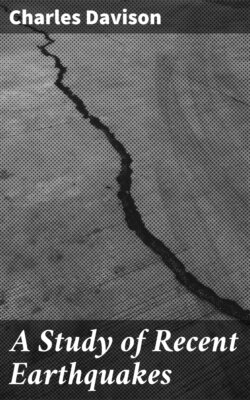Читать книгу A Study of Recent Earthquakes - Charles Davison - Страница 23
На сайте Литреса книга снята с продажи.
ORIGIN OF THE EARTHQUAKE.
ОглавлениеMallet's theories have suffered perhaps more than any other part of his work from the recent growth of our knowledge. From a historical point of view, some reference to his explanation of the origin of the Neapolitan earthquake seems desirable, and his own conscientious work demands it. On the other hand, his conclusions are, for the present at any rate, superseded, and it will therefore be sufficient to describe them briefly.
Most of the wave-paths, as we have seen, pass within three miles of a point almost coincident with the village of Caggiano. Of the remainder, six traverse a spot about two miles farther to the south-west, and three cross another about two miles farther to the north-east. Neglecting other points of intersection, but taking account of the observed emergences at Vietri di Potenza, Auletta, Polla, etc., Mallet infers that the horizontal section of the focus was a curve (indicated by the dotted line in Fig. 9) not less than ten miles in length, and passing from near Balvano on the north, close to Vietri di Potenza, Caggiano, and Pertosa, to a point about two and a half miles west of Polla. Again, he remarks, the observed emergences at places near the epicentre indicate that the vertical section of the seismic focus was either more or less curved, or more probably a surface inclined towards the south-east. He concludes, therefore, that the seismic focus was a curved fissure, 10 miles long and 3½ miles in height, and with its centre at a depth of 6½ miles below the level of the sea.
The production of this great fissure, accompanied, perhaps by the injection into it of steam at high pressure, was regarded by Mallet as the cause of the principal earthquake. He imagines that the rent would start at or near the central point of the focus and then extend rapidly outwards in all directions. In the initial stage, vibrations of very small amplitude would alone be transmitted, and these would give rise to the early sounds and tremors. As the rending proceeded, the vibrations would increase in strength up to a certain point when they produced the shock itself. After this, they would decrease; and, in the final stage, would give place to the small vibrations corresponding to the sounds and tremors that marked the close of the earthquake.
The rush of steam at high pressure into the focus Mallet does not seem to have considered essential, though he evidently regarded it as possible, indeed probable; and he suggests that it may have been in part the cause of the earthquake which occurred an hour later. Though feeling sceptical as to the existence of any general law of increase of underground temperature, he assumes it, for the sake of illustration, to be 1° F. for every 60 feet of descent. This would give a temperature of 339° F. at the upper limit of the focus, 643° F. at its central point, and 884° F. at its lower margin. If the focus were filled with steam at each of these temperatures, the corresponding pressures on its walls would be 8, 149, and 684 atmospheres, respectively. As the steam may be supposed to be admitted suddenly and to be unlimited in supply, Mallet infers that it might exist at the tension due to the highest of these temperatures, in which case it would be capable of lifting a column of limestone 8,550 feet in height (or about one-half the depth of the upper margin of the focus), and would exert a pressure on the walls of the focus of 4.58 tons per square inch, or of more than 640,528 millions of tons upon its whole surface.
So many pages have already been given to this interesting earthquake that I must sketch still more briefly my own view as to its origin. There were, I believe, two distinct foci with their centres about twenty-four miles apart along a north-west and south-east line, and it was to this arrangement that the elongation of the meizoseismal area was chiefly, though not entirely, due. The evidence is insufficient to determine whether the earthquake was caused by fault-slipping; it is in no way opposed to this view, but if the Neapolitan earthquake stood alone, we should hardly be justified in drawing any further inference. Relying, however, on knowledge obtained from the study of more recent shocks, it seems to me probable that the two foci formed parts of one fault with a general north-west and south-east direction. The slip causing the first part of the double shock apparently took place within the south-east focus, and was followed after a few seconds by one within the north-west focus, greater in amount as well as more deeply seated. In consequence of these displacements there were local increases of stress, causing numerous small slips within or near both principal foci; and, if we may judge from some slight shocks felt at La Sala, accompanied also by other minor slips in the intermediate region of the fault.
